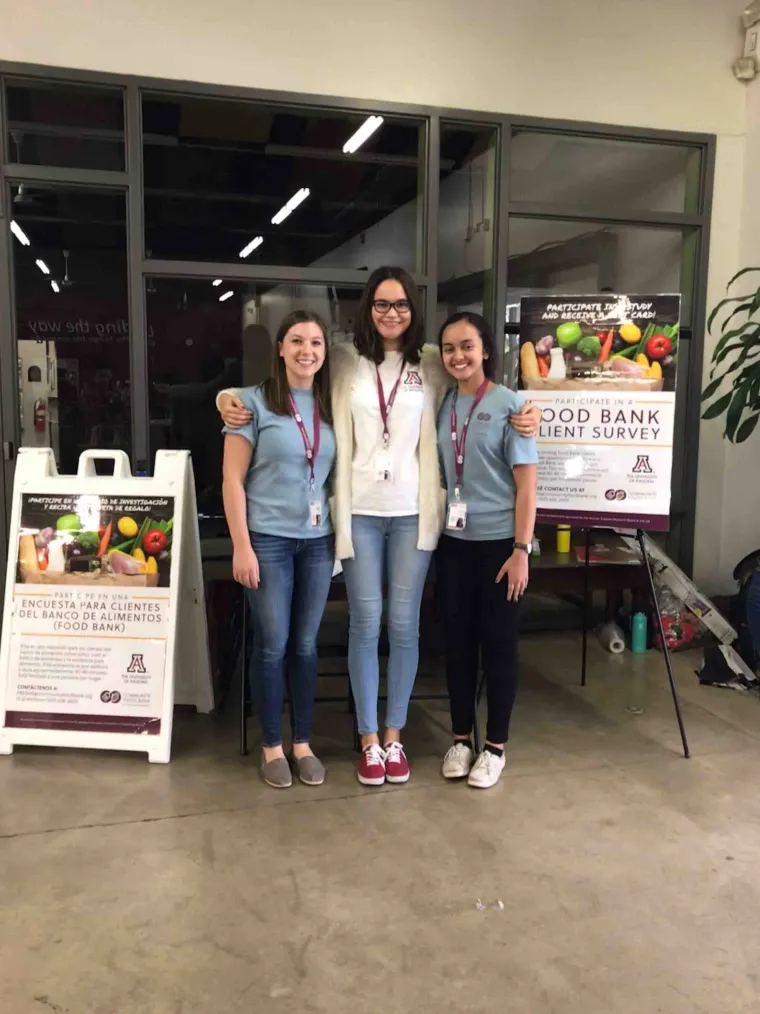Food as Medicine
A UArizona researcher forges partnerships to tackle diabetes in Arizona communities.

Students are often the face of UArizona community-engaged research, such as this partnership with the Community Food Bank of Southern Arizona.
Photo provided by Melanie Hingle
According to the Arizona Department of Health Services, there are almost 600,000 adults living with diabetes in Arizona, and it’s estimated that another 2 million have prediabetes. Meanwhile, Arizona ranks third highest among the 10 western states for food insecurity. Through her community-engaged research and partnerships, Melanie Hingle, a nutrition scientist, public health researcher and registered dietitian nutritionist in the University of Arizona College of Agriculture, Life and Environmental Sciences, is working to address these challenges.
“My lab is out there in the world,” Hingle says. Hingle works with community organizations that share the goal of diabetes prevention and management. Some partners, like El Rio Community Health Center, have an explicit focus on helping people manage their conditions and prevent disease. For others, like the Community Food Bank of Southern Arizona, the goal of diabetes management is more indirectly connected to their mission.
“A lot of their clients suffer from diet-sensitive illness, and they wanted to do something,” Hingle says.
For more than five years, Hingle has worked collaboratively with the two organizations to design food-based interventions to help combat diabetes for individuals also facing food insecurity.
“In the last decade or so, it became really clear to me that our work in diabetes prevention and management wouldn’t go anywhere unless we are addressing food and nutrition security as well,” Hingle says.
She describes food access, proximity to grocery stores and lack of financial security as major barriers to optimal nutrition. People with few resources, she says, may have to choose between buying fresh food, purchasing medication or paying utility bills.
“It’s impossible tradeoffs that people have to make when they just don’t have a lot,” she says. “The goal of our research and outreach is to help people to improve their health by connecting them with nutrition, food and medical resources. We are exploring whether something as simple as helping people secure enough nutritious food for their family can also help them to manage their diabetes.”
Hingle says that early in her career she thought diabetes management was just a matter of the right behavioral support.
“That was very naive of me to think that. Individual choices and behavior play a part, but there are a lot of factors beyond the individual that influence health,” she says. “Access to food and health care, educational opportunities, and the social and environmental context in which people live and work play a major role in health.”
Students in the School of Nutrition Sciences and Wellness who are training to be health professionals contribute to the community partnerships as well. Hingle says the school wants its students to understand how people navigate food and nutrition choices and provide support in culturally-responsive and budgetconscious ways. Culinary medicine, she explains, is a subdiscipline of nutrition that does just that. The emerging field, which is based on the idea of “food as medicine,” integrates nutrition science with culinary techniques and medical practice — with the goal of treating and preventing chronic, diet-sensitive conditions.
With the award of a five-year training grant from the USDA, Hingle worked with 20 undergraduate scholars as they participated in a series of experiences, including research and community outreach.
They participated in culinary medicine courses and, most recently, helped coauthor an open educational resource in culinary medicine — a free digital textbook for students and the public, to be published early next year.
Hingle is passionate about getting nutrition information into more people’s hands — and ensuring they’re connected with the resources that they need to act on that information.
“It’s fine if I tell you this certain food is healthy, but if you can’t access it, if you don’t know where to find it or don’t have the money to buy it — or if you don’t know how to cook it and enjoy it — it’s not going to be very helpful to you,” she explains.
Hingle is working to expand culinary medicine education at the university by partnering with Farshad Fani Marvasti, a practicing physician and director of public health, prevention and health promotion at the UArizona College of Medicine – Phoenix. Marvasti has been developing culinary medicine and nutrition programs for medical students, and he has joined Hingle on a grant initiative from Novo Nordisk, a global health care organization, to expand existing culinary medicine programs across Arizona. They are partnering with communities around the state to pilot new courses.
Hingle says food and nutrition access can affect everyone, not just a certain group of people. “The idea of food as medicine can positively impact everybody,” she says.
“Everyone will face health concerns at some point, whether themselves or someone in their family,” she says. “And one day they will benefit if their physician or the health professionals they interact with are well versed in nutrition and if food resources are available that they could use to improve their health using diet."
